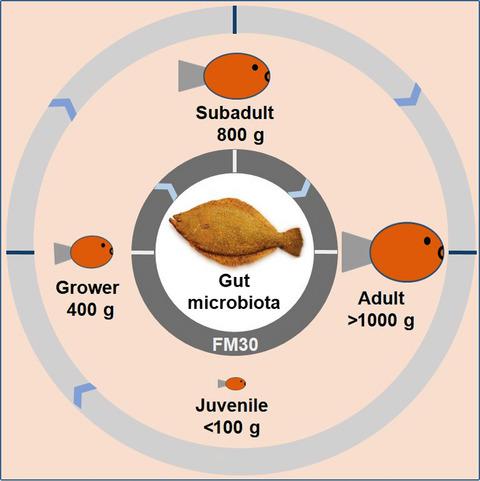当前位置:
X-MOL 学术
›
Microbiologyopen
›
论文详情
Our official English website, www.x-mol.net, welcomes your feedback! (Note: you will need to create a separate account there.)
Dietary effect of low fish meal aquafeed on gut microbiota in olive flounder (Paralichthys olivaceus) at different growth stages.
MicrobiologyOpen ( IF 3.4 ) Pub Date : 2020-01-11 , DOI: 10.1002/mbo3.992 Kai-Min Niu 1, 2 , Bong-Joo Lee 3 , Damini Kothari 2 , Woo-Do Lee 2 , Sang-Woo Hur 3 , Sang-Gu Lim 3 , Kang-Woong Kim 4 , Kyoung-Duck Kim 4 , Na-Na Kim 5 , Soo-Ki Kim 2
MicrobiologyOpen ( IF 3.4 ) Pub Date : 2020-01-11 , DOI: 10.1002/mbo3.992 Kai-Min Niu 1, 2 , Bong-Joo Lee 3 , Damini Kothari 2 , Woo-Do Lee 2 , Sang-Woo Hur 3 , Sang-Gu Lim 3 , Kang-Woong Kim 4 , Kyoung-Duck Kim 4 , Na-Na Kim 5 , Soo-Ki Kim 2
Affiliation

|
This study was conducted to investigate the long‐term effect of a low fish meal (FM) diet comprising plant‐based protein sources (PPS) on changes of gut microbial diversity in olive flounder (Paralichthys olivaceus) over the course of life. Two experimental diets were prepared to contain 74% FM (control) or 52% FM with 22% PPS (30% FM replacement, FM30). Fish were fed one of the two experimental diets for 8 months, and we collected the midgut contents to analyze the gut bacterial community by Illumina MiSeq based on the metagenomic sequences in the V3–V4 regions of 16S rRNA. We found that there were nine dominant phyla, which in turn presented Proteobacteria, Firmicutes, and Actinobacteria as the three major phyla in the gut microbiota of the flounder. At genus level, the dominant genera were Delftia, Prevotella, and Chthoniobacter at the juvenile stage (below 100 g/fish); Chthoniobacter, Bacillus, and Bradyrhizobium at the grower stage (400 g/fish); Chthoniobacter, Bacillus, and Delftia at the subadult stage (800 g/fish); and Lactobacillus and Prevotella at the adult stage (over 1,000 g/fish). The microbial diversity in olive flounders arched from the juvenile and subadult stage and reached a plateau thereafter. The fish fed the FM30 diet significantly had an increased abundance of Lactobacillus and Photobacterium and had less abundance of Prevotella and Paraprevotella than the control. However, the effect of dietary PPS was not significant on total microbial richness, indicating no negative effect as feed sources on the intestinal microbiota in olive flounder. These results indicate that the life stage of olive flounder is more important in modulating intestinal microbiota than is the diet. It could also be concluded that dietary PPS might be used as a potential fish meal alternative without any compromising effects on microbial diversity of olive flounder for long‐term feeding.
中文翻译:

低鱼粉水产饲料对不同生长阶段比目鱼(Paralichthys olivaceus)肠道菌群的饮食影响。
这项研究的目的是调查低鱼粉(FM)饮食(包括植物性蛋白质源(PPS))对生活中比目鱼(Paralichthys olivaceus)肠道微生物多样性变化的长期影响。制备了两种实验饮食,分别含有74%FM(对照)或52%FM和22%PPS(30%FM替代品,FM30)。将鱼喂食为两种实验饮食之一,持续8个月,然后我们收集中肠含量,通过Illumina MiSeq基于16S rRNA V3-V4区的宏基因组序列分析肠道细菌群落。我们发现有9个显性门,反过来,比目鱼肠道菌群中的变形杆菌,硬毛菌和放线菌为三大主要门。在属水平上,优势属是代尔夫特,普雷沃,和食土性细菌在幼年期(低于100克/鱼); 食土性细菌,芽孢杆菌属,和慢生根瘤菌在种植者阶段(400克/鱼); 食土性细菌,芽孢杆菌属,和代尔夫特在亚成体阶段(800克/鱼); 和乳杆菌和普氏菌在成年阶段(超过1000克/鱼)。橄榄比目鱼的微生物多样性从幼年期和亚成年期开始就呈拱形,此后达到了一个高原。喂养鱼的FM30饮食显著有大量的增加乳酸杆菌和发光杆菌并有丰富的少普雷沃和Paraprevotella比对照。然而,日粮PPS对总微生物丰富度的影响并不显着,表明作为饲料来源对比目鱼肠微生物群没有负面影响。这些结果表明,比饮食,橄榄比目鱼的生命阶段在调节肠道微生物群中更为重要。还可以得出结论,饮食中的PPS可以用作潜在的鱼粉替代品,而不会对长期喂养的比目鱼的微生物多样性造成任何损害。
更新日期:2020-01-11
中文翻译:

低鱼粉水产饲料对不同生长阶段比目鱼(Paralichthys olivaceus)肠道菌群的饮食影响。
这项研究的目的是调查低鱼粉(FM)饮食(包括植物性蛋白质源(PPS))对生活中比目鱼(Paralichthys olivaceus)肠道微生物多样性变化的长期影响。制备了两种实验饮食,分别含有74%FM(对照)或52%FM和22%PPS(30%FM替代品,FM30)。将鱼喂食为两种实验饮食之一,持续8个月,然后我们收集中肠含量,通过Illumina MiSeq基于16S rRNA V3-V4区的宏基因组序列分析肠道细菌群落。我们发现有9个显性门,反过来,比目鱼肠道菌群中的变形杆菌,硬毛菌和放线菌为三大主要门。在属水平上,优势属是代尔夫特,普雷沃,和食土性细菌在幼年期(低于100克/鱼); 食土性细菌,芽孢杆菌属,和慢生根瘤菌在种植者阶段(400克/鱼); 食土性细菌,芽孢杆菌属,和代尔夫特在亚成体阶段(800克/鱼); 和乳杆菌和普氏菌在成年阶段(超过1000克/鱼)。橄榄比目鱼的微生物多样性从幼年期和亚成年期开始就呈拱形,此后达到了一个高原。喂养鱼的FM30饮食显著有大量的增加乳酸杆菌和发光杆菌并有丰富的少普雷沃和Paraprevotella比对照。然而,日粮PPS对总微生物丰富度的影响并不显着,表明作为饲料来源对比目鱼肠微生物群没有负面影响。这些结果表明,比饮食,橄榄比目鱼的生命阶段在调节肠道微生物群中更为重要。还可以得出结论,饮食中的PPS可以用作潜在的鱼粉替代品,而不会对长期喂养的比目鱼的微生物多样性造成任何损害。



























 京公网安备 11010802027423号
京公网安备 11010802027423号